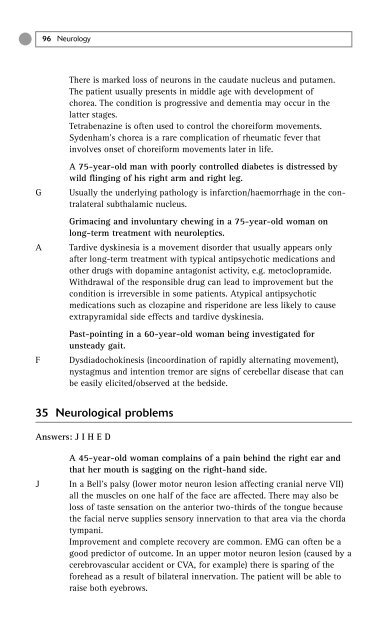EMQs in Clinical Medicine.pdf - Peshawar Medical College
EMQs in Clinical Medicine.pdf - Peshawar Medical College
EMQs in Clinical Medicine.pdf - Peshawar Medical College
Create successful ePaper yourself
Turn your PDF publications into a flip-book with our unique Google optimized e-Paper software.
96 Neurology<br />
There is marked loss of neurons <strong>in</strong> the caudate nucleus and putamen.<br />
The patient usually presents <strong>in</strong> middle age with development of<br />
chorea. The condition is progressive and dementia may occur <strong>in</strong> the<br />
latter stages.<br />
Tetrabenaz<strong>in</strong>e is often used to control the choreiform movements.<br />
Sydenham’s chorea is a rare complication of rheumatic fever that<br />
<strong>in</strong>volves onset of choreiform movements later <strong>in</strong> life.<br />
G<br />
A<br />
F<br />
A 75-year-old man with poorly controlled diabetes is distressed by<br />
wild fl<strong>in</strong>g<strong>in</strong>g of his right arm and right leg.<br />
Usually the underly<strong>in</strong>g pathology is <strong>in</strong>farction/haemorrhage <strong>in</strong> the contralateral<br />
subthalamic nucleus.<br />
Grimac<strong>in</strong>g and <strong>in</strong>voluntary chew<strong>in</strong>g <strong>in</strong> a 75-year-old woman on<br />
long-term treatment with neuroleptics.<br />
Tardive dysk<strong>in</strong>esia is a movement disorder that usually appears only<br />
after long-term treatment with typical antipsychotic medications and<br />
other drugs with dopam<strong>in</strong>e antagonist activity, e.g. metoclopramide.<br />
Withdrawal of the responsible drug can lead to improvement but the<br />
condition is irreversible <strong>in</strong> some patients. Atypical antipsychotic<br />
medications such as clozap<strong>in</strong>e and risperidone are less likely to cause<br />
extrapyramidal side effects and tardive dysk<strong>in</strong>esia.<br />
Past-po<strong>in</strong>t<strong>in</strong>g <strong>in</strong> a 60-year-old woman be<strong>in</strong>g <strong>in</strong>vestigated for<br />
unsteady gait.<br />
Dysdiadochok<strong>in</strong>esis (<strong>in</strong>coord<strong>in</strong>ation of rapidly alternat<strong>in</strong>g movement),<br />
nystagmus and <strong>in</strong>tention tremor are signs of cerebellar disease that can<br />
be easily elicited/observed at the bedside.<br />
35 Neurological problems<br />
Answers: J I H E D<br />
J<br />
A 45-year-old woman compla<strong>in</strong>s of a pa<strong>in</strong> beh<strong>in</strong>d the right ear and<br />
that her mouth is sagg<strong>in</strong>g on the right-hand side.<br />
In a Bell’s palsy (lower motor neuron lesion affect<strong>in</strong>g cranial nerve VII)<br />
all the muscles on one half of the face are affected. There may also be<br />
loss of taste sensation on the anterior two-thirds of the tongue because<br />
the facial nerve supplies sensory <strong>in</strong>nervation to that area via the chorda<br />
tympani.<br />
Improvement and complete recovery are common. EMG can often be a<br />
good predictor of outcome. In an upper motor neuron lesion (caused by a<br />
cerebrovascular accident or CVA, for example) there is spar<strong>in</strong>g of the<br />
forehead as a result of bilateral <strong>in</strong>nervation. The patient will be able to<br />
raise both eyebrows.












